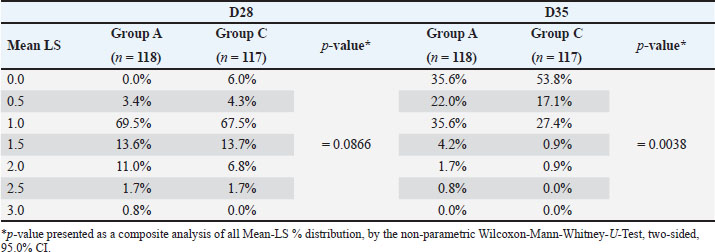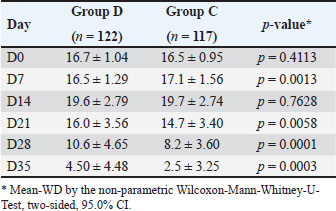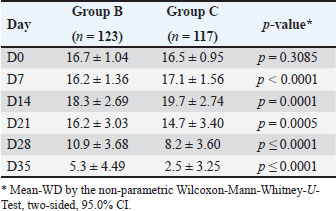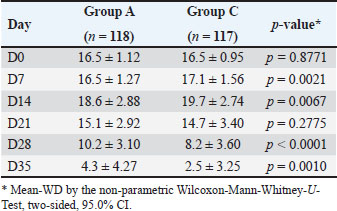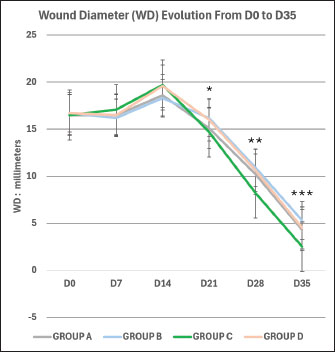
| Research Article | ||
Open Vet. J.. 2025; 15(9): 4106-4113 Open Veterinary Journal, (2025), Vol. 15(9): 4106-4113 Original Research Cautery disbudding in calves: A comparative assessment of topical wound treatmentsDavid Hawkins1, Amanda Carr1, Jacques Barnard2 and Paul Renaud3*1Franklin Veterinary Services Ltd., Auckland, New Zealand 2Vetoquinol New Zealand Ltd., Auckland, New Zealand 3Vetoquinol N.-A. Inc., Lavaltrie, Canada *Corresponding Author: Paul Renaud. Vetoquinol N.-A. Inc., Lavaltrie, Canada. Email: paul.renaud [at] vetoquinol.com Submitted: 20/05/2025 Revised: 10/08/2025 Accepted: 22/08/2025 Published: 30/09/2025 © 2025 Open Veterinary Journal
ABSTRACTBackground: Cautery disbudding is routinely performed on dairy calves to prevent horn growth. However, it creates open wounds that require effective management. Topical antibiotic products are commonly used, yet evidence supporting their efficacy is limited. Non-antibiotic alternatives may promote healing, thus supporting antimicrobial stewardship. Aim: To compare wound healing outcomes following cautery disbudding in calves treated with either a non-antibiotic aluminum aerosol bandage, an antibiotic spray, a combination of both, or no topical treatment. Methods: In this randomized multicenter study, 480 calves aged 7–35 days were assigned to one of four treatment groups: (A) antibiotic spray (10% oxytetracycline) plus an aluminum aerosol bandage, (B) antibiotic spray only (10% oxytetracycline), (C) aluminum aerosol bandage only, or (D) no topical treatment. All calves received sedation, local anesthesia, and analgesia. Wound healing was monitored via wound diameters (WDs; mm) and lesion score (LS; scale 0–3) every 7 days from Day 0 (D0) to Day 35 (D35) post-disbudding. Results: FromD0 to D21, group differences in WD and LS were inconsistent and mostly non-significant. However, by D28 to D35, calves in Group C (aluminum aerosol bandage only) showed significantly improved healing. At D35, mean WD (mean ± SD) in Group C was 2.5 ± 3.25 mm versus 4.3 ± 4.27 (Group A, p=0.0010), 5.3 ± 4.49 (Group B, p ≤ 0.0001), and 4.5 ± 4.48 (Group D, p=0.0003). Furthermore, at D35, the overall mean LS score in Group C was lower and showed improvement versus Group A (p=0.0038), Group B (p < 0.0001), and Group D (p=0.0006). Conclusions: Topical application of an aluminum aerosol bandage significantly reduced wound size and improved lesion scores in calves by D28 and D35 post-disbudding. These results suggest that a non-antibiotic aluminum topical spray offers an effective, welfare-supporting alternative when compared to antibiotic wound treatments. Keywords: Cautery, Disbudding, Topical, Treatment, Wound. IntroductionDisbudding—the removal of horn-forming tissue in calves—is widely practiced in dairy production to reduce injury risks for animals and handlers (Stock et al., 2013). When performed before two months of age, as recommended by animal welfare guidelines, the horn bud has not yet fused to the skull, making the procedure less invasive and more effective (Marquette et al., 2023). In calves under 2 months old, disbudding is typically carried out using one of two methods: cautery disbudding, which uses heat to destroy horn-forming tissue, or the application of a caustic paste that chemically burns the developing horn bud. In practice, cautery disbudding is more commonly used in dairy farms, due to its faster healing and lower risk of prolonged sensitivity (Drwencke et al., 2023). In many countries, regulations now require the use of local anesthetics during cautery disbudding to minimize pain (Reedman et al., 2020). However, less attention has been given to post-procedure wound care. It is common to apply topical antibiotic sprays—often containing oxytetracycline—to these disbudding wounds, despite limited evidence supporting their effectiveness (Stilwell and Laven, 2020). In some cases, these products may even delay healing by interfering with cellular repair processes (Stilwell and Laven, 2020). Given growing global concern over antimicrobial resistance, reducing the routine use of antibiotics is increasingly recognized as a priority for responsible antibiotic stewardship (Ridgway et al., 2022). This context highlights the need for evidence-based, non-antibiotic alternatives to support wound healing after disbudding. In this study, we evaluated whether a non-antibiotic topical treatment could support wound healing following cautery disbudding in neonatal calves. Addressing this gap is critical to improving calf welfare while promoting responsible antibiotic stewardship. Materials and MethodsStudy designWe conducted a randomized, multicenter study on three commercial dairy farms in New Zealand between July and October 2024. The study aimed to compare wound healing progression following cautery disbudding using different topical treatments. A total of 504 calves aged between 7 and 35 days and weighing 25.5 to 64.5 kg were enrolled. Calf breeds included Friesian, Jersey, Friesian-Jersey crosses, and beef-on-dairy crossbreds. Randomization was generated by S.E.R. (https://www.sealedenvelope.com/), with a seed value of 254956942428422. Calves were randomly assigned in blocks of eight animals to ensure equal allocation to one of four treatment groups (2:2:2:2). Due to the visible differences in spray color, blinding was not feasible. However, the principal investigator remained blinded to the clinical outcome data, and all randomization procedures were rigorously applied to minimize bias. Animal facilities and careCalves were housed in group pens with three-sided rearing facilities. Each of the 12 pens (approximately 2.7 × 9 m; 24 m2) was constructed with galvanized steel front gates and placed side by side. The back half of each pen was roofed with either a plastic tunnel house or a single pitch corrugated iron roof interspersed with polycarbonate clear-light panels. The front half of the pen remained open to the environment. Pens were bedded with non-treated wood chips and housed 10–15 calves each. Calves were managed in batches until approximately 6 weeks of age before being moved onto pasture. All calves received fresh colostrum from cows in the first 4 days of lactation, supplemented with vat milk as needed. Feeding volumes were breed-adjusted: Jersey calves received 4–5 l/day and Friesian calves received 5–6 l/day divided into morning and afternoon feedings. During the early phase of the study, colostrum comprised a greater proportion of the daily liquid feed. As the study progressed, vat milk became the dominant component of the ration. Table 1 displays the nutritional composition of the colostrum and milk. Proprietary calf meals containing 20% crude protein, 4% fat, and 36% starch were fed throughout the study. Clean, plumbed-in water was available ad libitum.Apart from the treatments associated with the cautery disbudding, only the first dose of a vaccine protective against clostridial disease (Coglavax®8, ACVM A007528, Ceva) was administered to enrolled calves. Table 1. Protein and fat composition of bulk fresh liquid feeds provided to calves during the study.
Cautery disbudding procedureTrained personnel performed all disbudding in accordance with New Zealand Veterinary Association guidelines (NZVA, 2024). Prior to disbudding, each calf underwent clinical screening and was weighed. Sedation was induced with xylazine (0.2 mg/kg IM; Phoenix Vet, New Zealand), followed by meloxicam (0.5 ml IM; 40 mg/ml; Metacam®, Boehringer Ingelheim Animal Health, New Zealand). Local anaesthesia was achieved with lidocaine 2% (2.5─5 ml per cornual nerve block site, Phoenix Vet, New Zealand). Cautery disbudding was performed using a butane-fuelled cautery dehorner with a 15 mm tip. To reduce the risk of variability and uneven wounds, experienced personnel applied the tip of the cautery dehorner to each horn bud for exactly 3 and 5 seconds, an approved maneuver and manipulation technique. Topical wound treatment groupsWithin 10 minutes of disbudding, calves received topical treatments according to their randomly assigned group. Calves in Group A received a 10% oxytetracycline hydrochloride aerosol spray (Tetravet® Blue, Bayer), followed immediately by a micronized aluminum aerosol bandage (Aluspray®, Vetoquinol). Aluspray® is commercialised under the EU license VPA10983/020/001, and the components are aluminum powder 4.0% w/w, and the excipients are liquid paraffin, liquified petroleum gas, and stearic acid. Group B calves received only the 10% oxytetracycline aerosol spray. Group C received only the micronized aluminum aerosol bandage. Group D (control) received no topical wound treatment. Sprays were applied to both horn bud wounds for three seconds per side, ensuring full wound coverage, and followed label instructions and study protocol. Importantly, no physical wound dressings (e.g., gauze or bandages) were used at any point in this study for any treatment group. Although the aluminum product is termed a “micronized aluminum aerosol bandage”, it is not a traditional bandage. Rather, the product forms a weather-resistant protective barrier over superficial wounds when sprayed on, without requiring any secondary covering. Clinical assessments and endpointsClinical assessments were conducted on Day 0 (D0) and then every seven days through Day 35 (D7, D14, D21, D28, and D35). On D0, calves were screened to confirm eligibility according to the study’s inclusion and exclusion criteria. Calf weights were recorded at this time, and the disbudding procedure and topical wound treatment were administered according to the group assignment. At each subsequent time point, three primary clinical parameters were assessed: lesion scores (LSs), wound diameters (WDs), and live body weight (LBW). LS were recorded using a standardized system: score (0) fully healed: wound completely covered by one layer of skin; (1) normal healing without a raised scab or exudate; (2) presence of raised scab or raised crust, without exudate; (3) presence of exudate, dry or moist, with or without residual scabbing. Scores from each animal were averaged to obtain a single LS value per animal. WD was measured in millimetres as the distance across the inner edges of the cautery ring at the widest point of each disbudding site. Again, measurements from left and right horn buds were averaged to obtain a single WD value per animal. LBW was recorded at each assessment using calibrated scales. Statistical analysesAll clinical data were systematically collected, validated, and recorded in data capture forms, and transferred by electronic file with a virtual locking system. The sample size was calculated using G*Power 3.1 based on a 45% prevalence of LS ≥ 2 in non-treated calves and an expected reduction to 22% in treated animals. With a two-sided alpha of 0.05, 90% power, and a 4:1 allocation ratio (treated:control), a total of 435 animals (87 control, 348 treated) was required. To account for uncertainties, a higher number of animals were included and randomized. LS and WD data, representing the arithmetic mean of the left and right horn buds for each animal, were summarized descriptively for each time point and treatment group. Comparisons of Group C (aluminum aerosol bandage) to Group A (oxytetracycline + aluminum), B (oxytetracycline only), and D (control) were performed using the non-parametric Wilcoxon-Mann-Whitney-U-Test (two-sided, alpha=0.05). No correction was applied for multiple comparisons. Statistical significance was defined as p ≤ 0.05, and indicative of a trend when 0.05 < p ≤ 0.10. These analyses were conducted using Testimate Version 6.5 (IDV Datenanalyse und Versuchsplanung, Gauting), a validated statistical software platform conforming to FDA 21 CFR Part 11 standards. LBW data were analyzed using descriptive statistics and MIXED procedure in SAS V9.4 to evaluate group differences at D35. The homogeneity criterion was the weight of the animal on D0, prior to cautery disbudding. Baseline homogeneity in calf body weight across treatment groups was assessed using the Kruskal–Wallis test. Ethical approvalThe study protocol was reviewed and approved by the COMETA ethical committee of Vetoquinol SA registered in 2012 as CEA no 88 with the French Ministry of Higher Education and Research (Ministère de l’Enseignement Supérieur et de la Recherche). Approval was granted on February 20th, 2024 (approval number 2024#2). All procedures adhered to the 3Rs—Replacement, Reduction, and Refinement—and complied with European animal welfare regulations. All activities were conducted following New Zealand’s regulatory framework for animal research. Both test and ancillary products were used in accordance with their approved Summary of Product Characteristics. Calves were housed under good husbandry conditions and monitored by trained personnel throughout the study. Although enrolled animals experienced more frequent handling than usual, no adverse effects on their welfare or quality of life were observed. ResultsA total of 504 calves underwent clinical evaluation, which included visual inspection, palpation, rectal temperature measurement, and body weight assessment. Of these, 24 calves were excluded from the analysis: 14 due to incomplete data sets, and 10 due to misinterpretation of calcified button lesions early in the study, which disrupted wound healing. These exclusions were distributed across groups, with no evidence of bias. The final analysis included 480 calves randomly assigned to treatment groups: 118 in Group A (oxytetracycline + aluminum), 123 in Group B (oxytetracycline only), 117 in Group C (aluminum only), and 122 in Group D (control). The mean age of enrolled calves was 18.6 ± 4.97 days, and the mean LBW of calves at enrollment was 42.6 kg ± 7.71 kg. Baseline weight was statistically homogeneous across treatment groups (p=0.255), confirming comparability at enrollment. LS assessmentsEach animal contributed two LSs (one per horn bud), which were averaged to yield a single mean LS per calf. Consequently, some scores included 0.5 decimal increments, reflecting intermediate healing stages not captured by whole-number categories. We expected wound healing to gradually improve for all groups over the 35-day observation period. However, the most notable and consistent differences between groups emerged at D28 and D35. Earlier assessments (D0–D21) showed no consistent or significant group differences, and where statistical differences occurred, they were transient. The p values presented in the following paragraph and related tables are based on overall comparisons of LS distributions between groups at D28 and D35. By D28, Group C showed significantly lower mean LS than Group D (p=0.0003), which persisted through D35 (p=0.0006; Table 2). When compared to Group B, Group C had a higher mean LS at D7 and D14, but this trend reversed by D28, with Group C trending toward improvement (p=0.1065) and achieving statistical significance by D35 (p < 0.0001; Table 3). Similarly, Group C showed higher mean LS values than Group A at D7 and D14, but by D28, a non-significant trend toward improvement emerged (p=0.0866), followed by significantly lower mean LS values at D35 for Group C compared with Group A (p=0.0038; Table 4). Table 2. LS progression from D28 to D35, post-cautery disbudding, comparing Group D (no treatment) and Group C (topical aluminum aerosol bandage).
Table 3. LS progression from D28 to D35, post-cautery disbudding, comparing Group B (10% oxytetracycline hydrochloride topical aerosol) and Group C (topical aluminum aerosol bandage).
Table 4. LS progression from D28 to D35, post-cautery disbudding, comparing Group A (10% oxytetracycline hydrochloride topical aerosol + topical aluminum aerosol bandage) and Group C (topical aluminum aerosol bandage).
WD assessmentsWD was measured at each disbudding site and averaged across both horn buds to yield a mean WD per calf. At D0 and D14, WD values were comparable between Group C and D. At D7, Group C had significantly larger mean WD than Group D. From D21 onward, Group C showed smaller WD values than Group D (p=0.0058), with increasing differences at D28 (p=0.0001) and D35 (p=0.0003; Table 5). Table 5. Mean (SD) WD measured as millimetres (mm) from D0 to D35, post-cautery disbudding, comparing Group D (Control) and Group C (topical aluminum aerosol bandage).
At D0, WD values were similar between Groups C and B (p=0.3085). At D7 and D14, Group C had significantly larger WD (p < 0.0001 and p=0.0001, respectively). From D21 onward, Group C consistently showed significantly smaller WD values than Group B (D21: p =0.0005; D28: p ≤ 0.0001; D35: p ≤ 0.0001; Table 6). Table 6. Mean (SD) WD measured as millimetres (mm) from D0 to D35, post-cautery disbudding, comparing Group B (10% oxytetracycline hydrochloride topical aerosol) and Group C (topical aluminum aerosol bandage).
At D0, WD values were comparable between Group C and A (p=0.8771). At D7 and D14, Group C had significantly larger WD values than Group A (p=0.0021 and p=0.0067). By D21, WD values in Group C were slightly smaller, although the difference was not statistically significant. At D28 and D35, WD was significantly smaller in Group C compared with Group A (p < 0.0001 and p=0.0010, respectively; Table 7). Table 7. Mean (SD) WD measured as millimetres (mm) from D0 to D35, post-cautery disbudding, comparing Group A (10% oxytetracycline hydrochloride topical aerosol + topical aluminum aerosol bandage) and Group C (topical aluminum aerosol bandage).
LBW assessmentsMean LBW at enrollment (D0) was 42.6 ± 7.71 kg across all groups and increased to 62.1 ± 9.93 kg by D35. No statistically significant differences in LBW were observed between treatment groups at either D0 or D35. DiscussionThis study evaluated the progression of wound healing in calves following cautery disbudding and compared outcomes among four treatment groups: a non-antibiotic aluminum spray, an antibiotic spray, a combination of both, and an untreated control. We observed significantly lower LSs and smaller WDs in calves treated with the aluminum aerosol bandage (Group C) compared to the other groups by D21–D35 (Fig. 1). These findings suggest that the micronized aluminum aerosol bandage was effective in supporting wound healing in the later stages of recovery.
Fig. 1. WD comparative evolution from D0 to D35, sourced from data in tables 5, 6 and 7. * D21: Group C versus Groups A (p=0.2775), B (p=0.0005), and D (p=0.0058). ** D28: Group C versus Groups A (p < 0.0001), B (p ≤ 0.0001) and D (p=0.0001). *** D35: Group C versus Groups A (p =0.2775), B (p=0.0005), and D (p=0.0058). Notably, differences between treatment groups were not apparent in the early stages of healing. This delayed divergence may be attributed to several factors. First, lesion scoring and WD measurement may not fully capture early inflammatory responses or microbial colonization that occur shortly after disbudding. A moist wound environment is an essential element of wound care, promoting re-epithelialization and improving wound healing (Tuca et al., 2022). While an aluminum aerosol bandage acts as a protective barrier and may preserve moisture and protect the wound environment, the effect may become more apparent after the initial inflammatory phase resolves. In contrast, the topical antibiotic treatment (Group B) may have provided a short-term benefit by reducing the bacterial contamination that could have developed in the 5–10 minutes between disbudding and treatment application. In uncomplicated healing, the wound typically dries out within 24 hours, becoming less susceptible to infection. By lowering early bacterial presence, the antibiotic spray could have led to reduced exudate and lower LSs in the initial days. Additionally, it is possible that the antibiotic spray suppressed the acute inflammatory response, temporarily preventing rejection of cauterized tissue. While this may have improved the wound’s appearance in the short term, it could have delayed full healing by postponing tissue clearance. Huebner et al. (2017), conducted a similar study with just two test groups—an aluminum aerosol bandage and a control—and observed comparable healing patterns to our study. In their trial, no significant differences were noted during the first 2 weeks, but by the third and final observation week, trends began to emerge in favor of the aluminum aerosol bandage treated group. Although these differences were not statistically significant, the delayed pattern of improvement mirrors the trajectory observed in our findings, suggesting longer follow-up periods may be necessary to fully assess treatment effects in disbudding wounds. Similarly, Adcock and Tucker, 2018, reported that most cautery disbudding wounds remained unhealed at Day 21, with full healing commonly extending beyond 3 weeks. In fact, wounds took 62 days on average to re-epithelialize. These findings reinforce that delayed treatment effects, such as those observed in our study, align with the expected biological timeline for wound resolution in disbudded calves. Additional factors may have influenced healing outcomes. Observations suggest that some wounds retained a calcified tissue fragment (“button”) at the bottom of the wound after disbudding, which may have prolonged the inflammatory response and delayed healing. In cases where granulation tissue grew over the button, eventual tissue retraction was needed to expel it. Moisture retention at the wound site may have supported this process by allowing the base and sides of the wound to remain joined, enabling the button to be expelled as a single large mass. This process may have triggered increased exudate due to the retained tissue acting as a foreign body, resulting in initially higher LSs and WDs, compared to cases where the cauterized tissue was expelled earlier. It is plausible that the aluminum aerosol bandage encouraged wound edges to remain joined, facilitating expulsion of the tissue mass and accelerating healing once it was removed. Consequently, in the absence of gross infection, the higher LSs and WDs observed in Group C at D7 and D14 may represent a necessary early inflammatory phase that contributed to the more complete and accelerated healing seen from D21 onward (Fig. 1). A combination of the previously discussed proposed mechanisms may explain the clinical pattern observed in Group C, where healing appeared initially slower but improved significantly over time. However, the LS and WD measurements alone may not fully capture the underlying biological processes driving these outcomes. Additionally, when considering the early results from Groups A and B, some aspects of the first 2 weeks of healing remain unclear and warrant further investigation. Disbudding remains a widely used management procedure. Survey data show that 94% of dairy farms in the United States of America and 95% in Canada routinely disbud calves, with cautery disbudding being the predominant method used on small to large operations (Reedman et al., 2021). A European report states that 81% of the dairy production systems, 47% of the beef production systems, and 68% of the suckler production systems use disbudding or dehorning (Marquette et al., 2023). Typically, cautery disbudding of dairy calves is done between 2 and 6 weeks of age. Although caustic pastes are an alternative method for young calves, they have been associated with prolonged healing. One study found that paste-induced wounds remained more sensitive than healthy tissue for at least 6 weeks and could take up to 18 weeks to fully heal (Drwencke et al., 2023). These findings highlight cautery disbudding as the preferred method in neonatal dairy calves and underscore the importance of effective, evidence-based wound management given the widespread practice of disbudding. This study’s strengths include a large, diverse sample size and rigorous randomization procedures, which reduce the risk of bias. However, LS and WD may not fully capture the early biological dynamics of wound healing. Additionally, due to the visible color of treatments, blinding was not possible, which may introduce observer bias despite standardized protocols. Future studies incorporating histological or microbiological endpoints could help clarify the mechanisms behind the observed outcomes. Another point to consider is the potential drawback of aluminum-based topical products. Although aluminum intoxication in ruminants is poorly documented, existing evidence discusses the very low risks but primarily concerns oral intoxication (Eppe et al., 2023). Consequently, the potential for aluminum transfer—either direct (e.g., through application to open muscle tissue) or indirect (e.g., via systemic absorption) that could affect food safety, remains uncharacterized. The product tested in this study is indicated and approved for superficial wounds, implying that when used according to label indications, it does not pose a known risk to food safety. However, if misused, such as by applying it to a gaping muscle wound, there may be an increased risk of aluminum entering consumable meat products. Therefore, topical aluminum use should be limited to approved indications to avoid potential off-label exposure routes. Perhaps future pharmacokinetic studies may help clarify systemic absorption risks. While topical antibiotics raise concerns related to antimicrobial resistance, aluminum-based aerosol bandages carry their own set of safety uncertainties, and the user should consider the pros and cons of both treatment types. As an additional note to the previously mentioned, there were no adverse clinical issues or observed side effects throughout this study with either topical product or the combination of both. In conclusion, this study demonstrated that a topical micronized aluminum aerosol bandage (Aluspray®) significantly improved wound healing in disbudded calves, particularly during the later stages of recovery. By D35, calves treated with the aluminum aerosol bandage had lower LSs and smaller WDs compared to those receiving antibiotic-based treatment or no treatment. We propose that these results are clinically relevant because a quicker healing progression of a wound, to completely cured, enhances the overall clinical outcome of the treatment and improves animal welfare. These findings support the use of aluminum aerosol bandage as a preferred option for post-disbudding care—one that improves wound healing, promotes animal welfare, reduces reliance on antibiotics, and aligns with global efforts to combat antimicrobial resistance. AcknowledgmentsFunding for this field trial was granted by Vetoquinol SA, 34 rue du Chêne Sainte-Anne, Magny Vernois, Lure Cedex 70204, France. The trial was conducted in three dairy farms under the medical supervision of Dr David Hawkins, Franklin Veterinary Services Ltd, Pukekohe, New Zealand. Statistical analyses were conducted by Marion Ocak, Dipl.-Stat., MD Research, Germany. Medical writing support was provided by Rhona Fraser, BSc, BVMS, United Kingdom. Conflict of interestAt the time this manuscript was drafted, two of the four authors (Paul Renaud, Jacques Barnard) were employed by Vetoquinol. SA, or one of its affiliates. Author contributionsDavid Hawkins: principal investigator, data compilation, manuscript review. Amanda Carr: study monitor, data collection, manuscript review. Jacques Barnard: study logistics, protocol review, manuscript review. Paul Renaud: study sponsor, protocol author, manuscript author. Data availabilityThe data that support the findings of this study are available from the corresponding author, upon reasonable request. ReferencesAdcock, S.J.J. and Tucker, C.B. 2018. The effect of wound healing and pain sensitivity in dairy calves. J. Dairy Sci. 101, 10361–10373. Drwencke, A.M., Adcock, S.J.J. and Tucker, C.B. 2023. Wound healing and pain sensitivity following caustic paste disbudding in dairy calves. J. Dairy Sci. 106, 6375–6387. Eppe, J., Salem, D., Rollin, F. and Guyot, H. 2023. Herd health troubles potentially related to aluminum grass silage content in dairy cows. Vet. Sci. 10, 149. Huebner, K.L., Kunkel, A.K., McConnel, C.S., Callan, R.J., Dinsmore, R.P. and Caixeta, L.S. 2017. Evaluation of horn bud wound healing following cautery disbudding of preweaned dairy calves treated with aluminum-based aerosol bandage. J. Dairy Sci. 100, 3922–3929. Marquette, G.A., Ronan, S. and Earley, B. 2023. Calf disbudding – animal welfare considerations. J. Appl. Anim. Res. 51(1), 616–623. NZVA. 2024. Policy: cattle disbudding and dehorning. Available via https://nzva.org.nz/positions-advocacy/position-statements/disbudding/ (Accessed 27 January 2024). Reedman, C.N., Duffield, T.F., Devries, T.J., Lissemore, K.D. and Winder, C.B. 2021. Graduate student literature review: role of pain mitigation on the welfare of dairy calves undergoing disbudding. J. Dairy Sci. 105, 6809–6819. Reedman, C.N., Duffield, T.F., Devries, T.J., Lissemore, K.D., Duncan, I.J. and Winder, C.B. 2020. Randomized controlled trial assessing the effects of xylazine sedation in 2- to 6-week-old dairy calves disbudded with a cautery iron. J. Dairy Sci. 104, 5881–5897. Ridgway, R., Neary, J., Turner, A., Barrett, D.C. and Gillespie, A. 2022. Evaluation of horn bud wound healing following cautery disbudding of dairy calves with and without the use of oxytetracycline aerosol spray. Front. Vet. Sci. 9, 745632. Stilwell, G. and Laven, R.A. 2020. Comparison of two topical treatments on wound healing 7 days after disbudding of calves using thermocautery. N. Z. Vet. J. 68(5), 304–308. Stock, M.L., Baldridge, S.L., Griffin, D. and Coetzee, J.F. 2013. Bovine dehorning: assessing pain and providing analgesic management. Vet. Clin. Food Anim. 29, 103–133. Tuca, A.C., Bernardelli De Mattos, I., Funk, M., Winter, R., Palackic, A., Groeber-Becker, F., Kruse, D., Kukla, F., Lemarchand, T. and Kamolz, L.P. 2022. Orchestrating the dermal/epidermal tissue ratio during wound healing by controlling the moisture content. Biomedicines 10, 1–16. | ||
| How to Cite this Article |
| Pubmed Style Hawkins D, Carr A, Barnard J, Renaud P. Cautery disbudding in calves: A comparative assessment of topical wound treatments. Open Vet. J.. 2025; 15(9): 4106-4113. doi:10.5455/OVJ.2025.v15.i9.15 Web Style Hawkins D, Carr A, Barnard J, Renaud P. Cautery disbudding in calves: A comparative assessment of topical wound treatments. https://www.openveterinaryjournal.com/?mno=259533 [Access: November 28, 2025]. doi:10.5455/OVJ.2025.v15.i9.15 AMA (American Medical Association) Style Hawkins D, Carr A, Barnard J, Renaud P. Cautery disbudding in calves: A comparative assessment of topical wound treatments. Open Vet. J.. 2025; 15(9): 4106-4113. doi:10.5455/OVJ.2025.v15.i9.15 Vancouver/ICMJE Style Hawkins D, Carr A, Barnard J, Renaud P. Cautery disbudding in calves: A comparative assessment of topical wound treatments. Open Vet. J.. (2025), [cited November 28, 2025]; 15(9): 4106-4113. doi:10.5455/OVJ.2025.v15.i9.15 Harvard Style Hawkins, D., Carr, . A., Barnard, . J. & Renaud, . P. (2025) Cautery disbudding in calves: A comparative assessment of topical wound treatments. Open Vet. J., 15 (9), 4106-4113. doi:10.5455/OVJ.2025.v15.i9.15 Turabian Style Hawkins, David, Amanda Carr, Jacques Barnard, and Paul Renaud. 2025. Cautery disbudding in calves: A comparative assessment of topical wound treatments. Open Veterinary Journal, 15 (9), 4106-4113. doi:10.5455/OVJ.2025.v15.i9.15 Chicago Style Hawkins, David, Amanda Carr, Jacques Barnard, and Paul Renaud. "Cautery disbudding in calves: A comparative assessment of topical wound treatments." Open Veterinary Journal 15 (2025), 4106-4113. doi:10.5455/OVJ.2025.v15.i9.15 MLA (The Modern Language Association) Style Hawkins, David, Amanda Carr, Jacques Barnard, and Paul Renaud. "Cautery disbudding in calves: A comparative assessment of topical wound treatments." Open Veterinary Journal 15.9 (2025), 4106-4113. Print. doi:10.5455/OVJ.2025.v15.i9.15 APA (American Psychological Association) Style Hawkins, D., Carr, . A., Barnard, . J. & Renaud, . P. (2025) Cautery disbudding in calves: A comparative assessment of topical wound treatments. Open Veterinary Journal, 15 (9), 4106-4113. doi:10.5455/OVJ.2025.v15.i9.15 |








